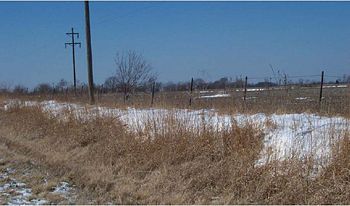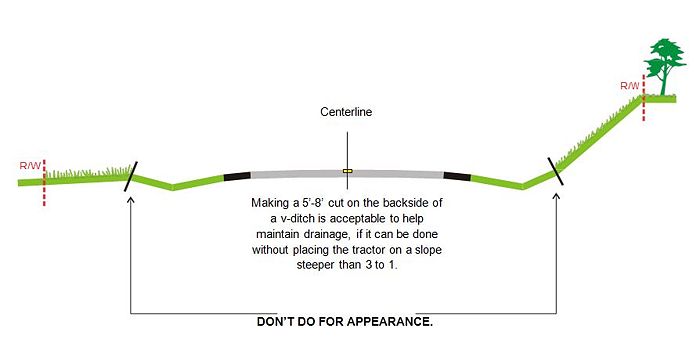822.4 Recommended Practices
The sharing of best practices among districts results in greater efficiency and effectiveness.
Personnel engaged in mowing should be trained in the operation of mowers and must be familiar with the applicable safety guidelines. Safety information is available at http://sharepoint/systemdelivery/MT/SitePages/Roadsides.aspx.
Contents
Fleet
1. Fleet composition should be examined and comprised of tractors and mowing attachments that are optimal for the terrain and obstacles that are present in specific areas.
2. Accurately enter and maintain mower attachments inventory in FASTER. Stagger equipment inspections according to season. This allows for equipment to be properly inspected and all repairs made prior to the beginning of season.
Materials
1. EPG 821 Herbicides and Roadsides should be used as a guideline for herbicide programs.
2. A pre-season meeting to discuss herbicide treatments should be held.
Communication
1. Discuss mowing plans during statewide conference calls to increase consistency between districts. This is also recommended on a district level to improve consistency between areas.
2. Develop a district specific vegetation management plan, including herbicides and mowing. The plan should also be communicated and readily accessible to district and division maintenance personnel.
3. When a major route corridor spans district lines, the districts should work together to ensure no abrupt changes in roadside management practices are apparent at district or area boundaries. Provide speaking points for customer service representatives and other district personnel to consistently answer questions from the public regarding mowing practices.
4. Collaborate with district communications personnel to create public information pieces to inform our customers on work that will be completed. Examples of successful public relations pieces are news releases, fliers, social media posts, and information posted on the website.
5. Communicate herbicide and PGR plans (recently completed and upcoming) to mowing personnel.
Labor
1. Analyze the area with the purpose of mapping out a circular route to increase efficiency by eliminating or significantly reducing deadheading.
2. Actively monitor working hours and overtime of personnel by flexing work schedules during the work week once an employee reaches 40 hours.
3. Encourage short mowing cycles with all mowers operating, and make mowing a focused priority during scheduled mowing times. This will help save money on labor and mobilization, and improve consistency.
Operations
1. Encourage the expansion of the Adopt-A-Highway Program for mowing.
2. Develop and encourage areas of native vegetation including pollinator-beneficial vegetation.
3. The Roadside Vegetation Management policy, guidelines and recommended practices will be reviewed as needed.
Trimming
1. Trimming should be evaluated for need at each mowing cycle.
2. The use of total vegetation control (bareground) should be limited to a 30 in. radius around signs to limit erosion problems.
Safety
1. Tractor tires should be set at the appropriate width and inflation that provides optimum stability. Always consult the operator's manual before making any adjustments to the tractor tires.
2. For safety concerns and appearance purposes, a cut should not be made on top of rock cuts or down from the top of an unmowed slope. May be mowed for sight distance if needed.
3. Dead trees and limbs, fallen or standing, which may create a hazard, should be promptly removed. Trees on the roadway should be removed as soon as possible, suspending other lower priority work if necessary.
Appearance
1. Coordination of the mowing effort is important not only between areas but between districts to ensure that no abrupt changes in roadside management practices are apparent at district or area boundaries.
2. The transition between mowing widths and patterns will vary and should be gradual to give a natural and pleasing appearance.
3. All required trimming should be completed with each mowing cycle. PGRs plus a broadleaf herbicide applied in the spring prior to seedhead development will help control vegetation height and reduce the need for trimming. Total vegetation control may be used around objects with care.
4. Litter visible to roadway travelers should be removed prior to and after each mowing cycle. Coordinate with incarcerated personnel activities where available.
5. Landowners are allowed to mow the right of way adjacent to their property.
Herbicides
1. Only herbicides in EPG 821 Herbicides and Roadsides are approved for use. Other herbicides must be approved by Central Office Roadsides.
2. Undesirable weeds should be controlled by either chemical or biological means.
3. An effective herbicide program is a strong part of a properly managed roadside.
4. Herbicides may be used to keep sidewalks, paved slopes, paved islands, paved shoulders, commuter parking lots, drains, pavement joints, barriers, curb lines, paved ditches, etc. free of vegetation. If growth does occur in these areas, the vegetation should be removed.
5. Invasive plant species should be controlled that are considered mutually undesirable by MoDOT and adjacent landowners.
Cultural Practices
1. Erosion control measures may be necessary if there is not adequate vegetation to prevent erosion or if operations require removal of vegetation and there is a possibility that silt or sediment will leave the right of way.
2. Fertilization and/or reseeding should be considered where difficulty in establishing vegetation is encountered.
3. Mowing height is the actual height of cut to prevent scalping and other damage.
4. Do not mow when turf and soil conditions are wet to the point that turf damage or ruts will occur.
5. Native vegetation should be left standing and encouraged in areas that are prone to drifting snow.
6. Delayed mowing allows for seed production which may result in healthier stands of turf.
7. Mowers should be regularly cleaned to eliminate the spread of weeds, especially if mowing noxious or problem weeds.
Miscellaneous
1. Refer to your district roadside representative for assistance.
2. When mowing to the ditch line, it is acceptable to make a 5 to 8 ft. cut on the back side of a V-ditch to help maintain drainage if it can be accomplished without placing the tractor on a slope steeper than 1V:3H (3 to 1) or causing damage. A cut on the backside of the ditch should not be made for appearance purposes. The preferred alternative is the selective use of herbicides.
3. Areas of wildflower, native grass and tree plantings may be signed to indicate what is being accomplished at these locations.
4. Areas around and under bridges should be kept clear of brush and may be mowed if done without placing the tractor on a slope steeper than 1V:3H (3 to 1). The selective use of herbicides is the preferred control method.
5. Culverts should be kept clear of brush.
6. Control the vegetation around the continuous traffic monitoring sites to allow access. Use incarcerated personnel if possible. Total vegetation control should be used for season-long control. The treated area should not be very large to reduce erosion. The link to the box locations is http://sharepoint/systemdelivery/TP/sysanlysis/dmas/Shared%20Documents/Maps/Other%20Maps/ATRStatewide2014.pdf.
Mowing and Spraying Strip Widths
| Strip Width (ft.) | Approximate Acreage per One Mile | Miles Traveled to Equal one Acre | Strip Width (ft.) | Approximate Acreage per One Mile | Miles Traveled to Equal one Acre | |
|---|---|---|---|---|---|---|
| 1.0 | 0.12 | 8.25 | 8.0 | 0.97 | 1.03 | |
| 2.0 | 0.24 | 4.13 | 9.0 | 1.09 | 0.92 | |
| 3.0 | 0.36 | 2.75 | 10.0 | 1.21 | 0.83 | |
| 4.0 | 0.48 | 2.06 | 11.0 | 1.33 | 0.75 | |
| 5.0 | 0.61 | 1.65 | 12.0 | 1.45 | 0.69 | |
| 6.0 | 0.73 | 1.38 | 14.0 | 1.70 | 0.59 | |
| 7.0 | 0.85 | 1.18 | 16.5 | 2.00 | 0.50 |

